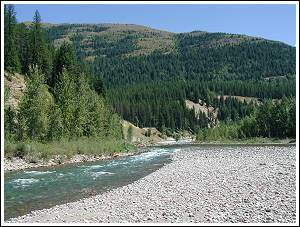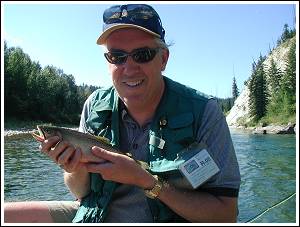|

Dry
Fly Dream:
Fishing the
Middle Fork of the Flathead River
By Tom Layson
The first thing that hits you is the smell. Nothing smells quite like
a healthy freestone river in the American west, and the Middle Fork of
the Flathead River is a perfect example of what a remote location and
a Wild and Scenic designation can do to preserve what must be pretty
close to a pristine fishing experience.
After flying
into Kalispell, Montana and spending a few days with family at
Whitefish Lake, my trip started one crisp August morning at the
Glacier Raft Company's outdoor center a half mile west of Glacier
Park's west gate on U.S. Highway 2. That's where I met guide Dan
Harrison for what would be a truly memorable day of fly-fishing.
After picking
five or six likely suspects out of the center's substantial inventory
of hand tied flies, we were off for a half hour drive to the east on
Highway 2 as it runs upstream along the Middle Fork, and the western
border of Glacier National Park.
We put our
two-seat raft into the water at the Paola access point, less than 100
yards off the highway. As Dan was loading gear, I peered into the
crystal clear water and instantly spotted a 2-inch long gray Stone Fly
skittering across the surface. I pointed this out to Dan, who gave me
a knowing nod and invited me to take my place on the high seat up
front.

Dan is a
25-year-old field biologist by training, and a former fish-habitat
biologist with the New Hampshire Department of Fish and Game who isn't
ready to get off the river for a "real job" any time soon.
When it came to explaining the Middle Fork's unique feeding patterns,
biota, and fishing strategies, I knew that he knew; If you know what I
mean.
Nosing the
raft downriver, we cruised the first 100 yards of what would be a 13
mile journey through some of the most spectacular country, and
pristine river, I've had the pleasure of experiencing. Water
conditions from about mid-July through early August are just about
perfect: Too low for the heaviest rafting crowds, but high enough to
make the river entirely floatable for fishing trips.
The first
thing you notice onboard is the stunning clarity of the water. Gliding
over 50-foot deep azure pools, one could easily see straight to the
bottom. Deeply submerged boulders provide plenty of cover for hungry
Westslope Cutthroat and Bull Trout, which monitor the surface for any
promising ripple once temperatures rise enough for insect activity to
begin. This is something that was hard to get used to. Fishing here
isn't early; it's late because of the extremely low temperatures of
the water overnight and into the early morning.

Our setup was
fairly straightforward: A two-piece graphite 5-weight rod and reel
combination, and a short, 7-foot mono leader with a 4-5x tippet. On
the business end of the rig was a "Fat Albert," which to the
rest of the world is a size six foam and rubber stonefly with a small
parachute. We fished a gray version most of the day, but also toyed
with an orange Fat Albert and a Red Wulff when we thought we'd
educated a big one a couple of times. Mostly though, the foam stonefly
was the meal ticket du jour.
Dan and I
started working together well very early on. He'd set me up right or
left, suggest mends, and say, "this is lookin' fishy" when
he liked the water, and my fly's float. On my third or fourth cast as
he quietly murmured, "great float, great float," we got the
first strike. It came in a choppy section of deep blue tail water
alongside a series of boulders. The surface roiled as an eager
Cutthroat took a swipe at my foam offering. I did not hook him.
Fishing in gin
clear water takes a little patience. I'm not used to casting to
sighted fish, and the tendency to jump-the-strike is strong when you
can actually see a streaking silver bullet rushing your fly from ten
or 20 feet down. After a while though, you get it right, and you've
lip-hooked your first Weststlope Cutthroat.

I have nothing
but good things to say about Rainbow, Brook, and Brown trout. They are
friends of mine, and I value their company. However, no trout I've
ever caught comes anywhere close to pulling as hard as the Westslope
Cutthroat. Inch-for-inch, they are the hardest fighting freshwater
fish I've ever come across. Even a 10-inch Westslope will run line off
your reel and make many valiant attempts for the strong mid-river
current, and deep lies he knows at the bottom. This is a
catch-and-release section of river though, and in my mind,
"horsing" the fish a little is preferred to keep them from
exhaustion.
The river is a
geologist's dream with strange outcroppings, shelves, sharply defined
striations of layered rock, undercut subsurface shelves, and
precipitous drop-offs that teem with hungry trout. The river's parent
rock, Argillite, isn't considered to be too fish-friendly when it
comes to producing nutrients, but the fish population seemed very
robust in most of the stretches we fished. Bear in mind too that we
fished in the "recreational" section of this river,
downstream from the fly-in sections that run through the Great Bear
Wilderness.
As we worked
out way downstream, the action got hotter as we moved toward midday,
and the insect activity increased. Dan helped me read the foam lines,
and encouraged me to cast into heavier water than I would normally
select. The aggressive cutthroat did not disappoint, eagerly slapping
the bobbing Fat Albert with reckless abandon.

We actually
raised quite a few fish dragging the bug on the turn. Dan warned me
that this breeds bad habits among the novices who, once they see this,
are reluctant to go back to trying for that perfect dead float. In
fact, during our lunch break, I caught a 14-incher while stripping
line and dragging the bug upstream six inches from the shoreline. I
saw him follow all the way from mid-channel, and figured I'd just
"troll" until he hit: Which he did. Hard. Most of our 20 or
so fish were taken on a traditional dead float though, especially the
two big ones we landed.
It was just
before noon that we had a nice 40 or 50-foot float going. We were
fishing the North bank of the river right on the heavy current where
the river turned from robin's egg to navy blue. In a flash, a larger
silver slab curled over the top of my fly and started pulling my
tippet toward some nook in a subsurface boulder field. I set the hook,
and felt the heavy pull of something out-of-the-ordinary. This fish
meant business.
I had several
yards of stripped line at my feet and hand-played the fish on its
initial blinding run into the heavy current. But I knew I wanted this
fish on the reel, so after paddling-away at the little Orvis to take
up the slack, I got it done, after what seemed like an hour.
By this time,
our fish was not very happy. Yes, the meaty beast was finally on the
reel, but that didn't stop him from immediately stripping my fly line
with abandon. This time though I wasn't relying on my marginally
reliable fingertip drag to keep him from breaking me off. I had the
reel palmed as he made a play for my backing.
The Westslope
Cutthroat isn't a jumper. No, he's a head shaker, a strong runner, and
a cunning strategist. This fish would rest until I tried to put a
little pressure on him. At that point he would shake his head. Then,
when sensed that I just about had the reel locked-down with my palm,
he'd make another sharp run in hopes, no doubt, of breaking me off.

After 15
minutes of this, Dan finally netted what turned out to be the first of
two 16-inch fish we'd take that fine summer day. Dan told me they were
a couple of the larger Westslopes that had been landed this season.
Actually, even after a couple of these 15 minute fights, I
bulled-the-fish-in a little more than one might usually do, again, in
hopes of not bringing them to exhaustion. Dan tells me that hooking
mortality is actually pretty low since the Westslope is a hearty
species. That's good to hear, but they're a resource that's worth
taking extra measures to protect.
Despite all
the new development around Kalispell, Whitefish, and West Glacier, the
Middle Fork of the Flathead River is still a great fishing experience.
The presence of U.S. Highway 2 spooks me a little, as does the heavy
overnight rafting trade. But if managers can at least maintain what we
have there now, it is a wonderful resource that offers a unique dry
fly fishing experience.
There is
nothing like a surface strike, and with the right conditions and the
right knowledge, a memorable experience is within fairly easy reach on
the middle fork of Montana's Flathead River.
-###-
Resources:
Glacier Raft Company: http://www.glacierraftco.com/
Horizon Airlines: http://www.alaskaair.com/
Montana Fish and Game: http://fwp.state.mt.us/
By
Tom Layson
2005 ©
|